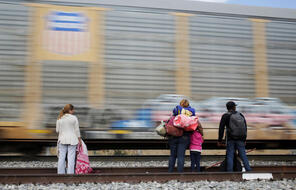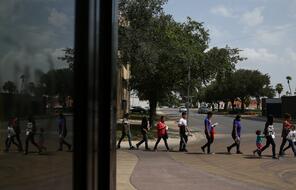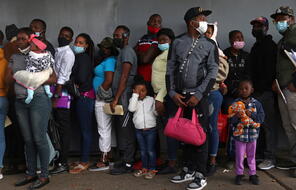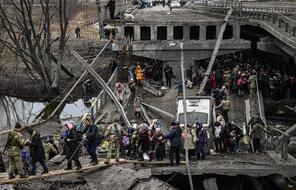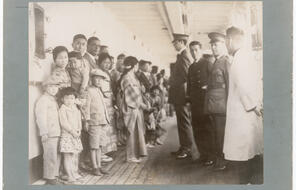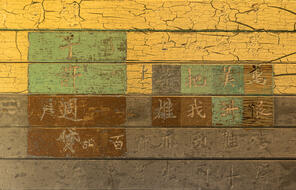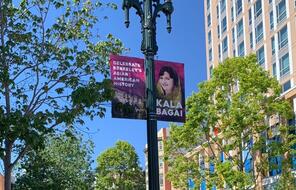Overview: What Are Borders?
At a Glance
Language
English — USSubject
- History
- Social Studies
- Global Migration & Immigration
What do borders do, mean, and look like in different parts of the world? How are they decided? Who or what might they protect? How might they do harm? How and why might they change? The following overview from the National Geographic Society considers these and other important questions about borders in the modern world.
A border is a line that separates areas. Borders can be real or made up by people. Borders separate countries, states, provinces, counties, cities, and towns. A border defines the area that a government controls. The government of a region can only create and apply laws within its borders.
Borders change. Sometimes the people in one area take over another area. Sometimes land is traded or sold peacefully. Many times, land is divided among governments after a war.
Travel Between Countries
Sometimes borders fall along natural boundaries like rivers or mountain ranges. For example, the boundary between France and Spain follows the peak of the Pyrenees mountains. For part of its length, the boundary between the United States and Mexico follows a river called the Rio Grande.
Borders—especially borders for countries—affect travel. Borders also affect people moving from one country to another.
Countries with similar wealth and similar types of government are often more welcoming to each other. Such countries often keep their borders open, without members of the military watching over them.
Other parts of the world have very different rules. The Korean Demilitarized Zone is the border between North Korea and South Korea. It separates the two countries with fences, explosives and soldiers. Citizens of other countries must have a passport and permission to enter North Korea. However, North Koreans must also have permission from the government before they leave the country.
Every country has its own border rules. These rules are how a country decides who may travel, work and live within its borders.
Visas and work permits are government documents. They are issued to non-citizens. Visas and work permits limit the type of work or travel they may do in the country, and for how long. The United States issues "green cards," also known as permanent resident cards. Green cards allow people from other countries to live and work inside the borders of the U.S. and be protected by its laws.
Border Protection
Countries protect their borders for several reasons. This is especially true in areas where two or more countries have fought over the same land. Cambodia and Thailand are countries in Southeast Asia. They have disputed the territory of the Preah Vihear Temple for more than a century.
Sometimes, borders keep citizens from leaving a country. Nations like North Korea, Myanmar and Cuba rarely allow their residents to cross their borders.
Border Disputes
Many border disputes happen when people fight over natural resources. Natural resources are anything a person can use that comes from the natural environment. The countries of Sudan and Egypt have argued for years over a region called Hala'ib. Hala'ib is rich in the mineral manganese, a natural resource. Manganese is important for making iron and steel.
Borders often divide groups of people who have similar ways of life. The groups might believe in the same religion. They might follow the same traditions and speak the same language.
The nation of Germany was divided between East Germany and West Germany after Germany lost World War II. The border between the countries lasted from 1949 to 1989. Germany became one country again in 1990.
Many times, one ethnic group wishes to break off and form its own independent state. This can lead to civil war.
The area of southeastern Europe known as the Balkans has a long history of fighting over borders.
After World War II, a country called Yugoslavia adopted communism. Communism is a type of government where people can't own property because all property is considered shared. The government usually divides wealth equally among people or according to what people need. This does not always work very well, though.
After communism began to decline in the early 1990s, various groups started fighting for control in the Balkans. Yugoslavia was home to many different groups of people. Several groups fought to have their own countries. As a result, the area that used to be Yugoslavia is now seven separate countries.
Border problems often come up when people from other regions take over an area and create borders. During the 1800s and 1900s, European countries colonized much of Africa. In other words, outsiders from Europe moved into Africa. They took control of the people there. They took the land as their own. European colonists created the borders of most African countries. However, the borders they made often did not always consider the different groups living in an area.
By the late 1960s, most African nations had gained freedom from European colonists. After Belgian troops left Central Africa, two tribes, the Hutus and the Tutsis, began fighting. In 1962, two new countries were formed. Rwanda was led by Hutus. Burundi was led by Tutsis. In 1994, a genocide in Rwanda left hundreds of thousands of people dead.
Today, African leaders are working to create stable, peaceful borders. In January 2011, the citizens of southern Sudan voted to form their own nation. The president of Sudan accepted the vote.
Border disputes can also develop as communities seek to establish their own city. This process is called incorporation. Many rural or suburban residents resist incorporation. They prefer to be an unincorporated part of a county, instead of affiliated with a town or city. They say it will lead to more taxes and government rules.
Other residents support incorporation. They say incorporating as a town or city will give them more independence on issues like law enforcement and education. 1
- 1National Geographic Society (adapted by Newsela staff), “Overview: What are borders?,” Newsela website, Sept. 5, 2017, accessed April 24, 2019.
How to Cite This Reading
Facing History & Ourselves, “Overview: What Are Borders?,” last updated May 22, 2019.
This reading contains text not authored by Facing History & Ourselves. See footnotes for source information.


